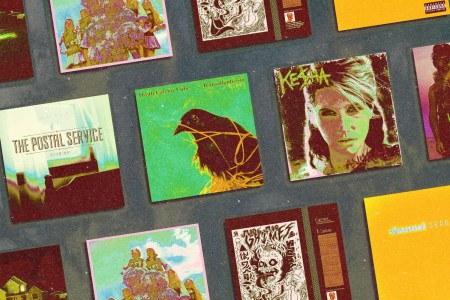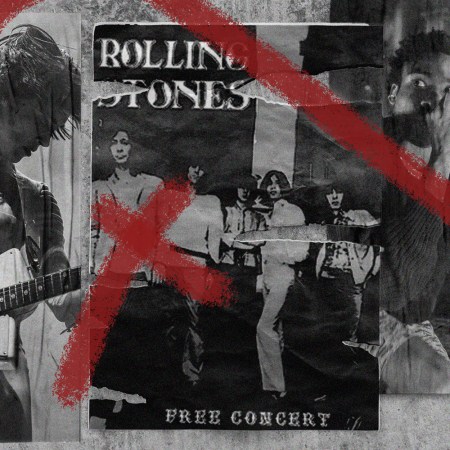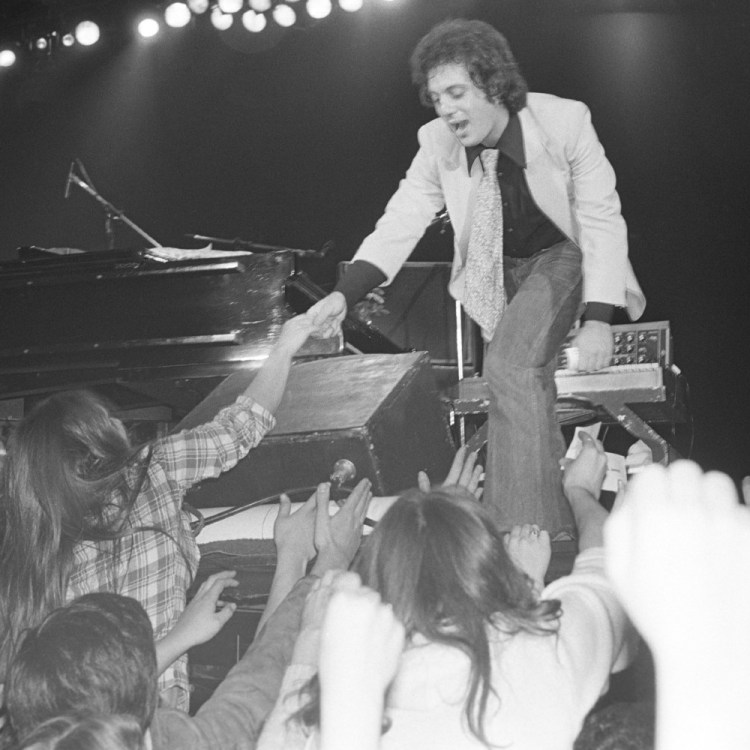For roughly two weeks toward the end of this coming August, The Killers will be planting stakes in their hometown of Las Vegas for a condensed residency at the Colosseum at Caesars Palace. Announced at the beginning of the year as a means of celebrating the 20th anniversary of the band’s breakthrough debut Hot Fuss, the shows will feature the group performing the album from start to finish for the first time. While those able to land tickets to these exclusive shows will undoubtedly look forward to hearing beloved tracks such as “Somebody Told Me” and “All These Things That I’ve Done,” in their original sequence, it will be early on in the band’s set — somewhere around the four-minute mark — that the audience will erupt perhaps to its loudest levels of enthusiasm, triggered by Dave Keuning’s now infamous arpeggio-ed riff for “Mr. Brightside.”
Twenty years after the fact, “Mr. Brightside” remains one of those songs, a piece of pop music with a staying power — if not outright growth in popularity — that seems inexplicable and yet entirely warranted. Immediately propulsive, with the kind of anxious energy that feels like at any second the whole thing is going to trip over its own established time signature, its cathartic sense of optimism and promise of recovery in the face of sudden romantic betrayal continues to make “Mr. Brightside” the kind of communal anthem that feels as if it has always existed, and will always exist.
“Mr. Brightside” of course did in fact start somewhere. According to music journalist Mark Beaumont, who chronicled the band’s early years in his 2016 biography The Killers: Days & Ages, “Mr. Brightside” coincided with the very origin of The Killers, when in 2001 frontman Brandon Flowers became the only respondent to a personal ad Keuning had placed in a local Las Vegas newspaper.
As a means of determining how the two of them could potentially work together, Keuning gave Flowers a cassette of various melodies and hooks he had cobbled together to see if anything could mined from the unfinished ideas. At the time Flowers was suffering from a broken heart, having recently discovered that his girlfriend was cheating on him, catching her with another man at a bar she and Flowers would often frequent together.
Upon hearing that now-classic riff for the first time, Flowers used this recent blow to his love life for lyrical fodder. Within the span of just a few rehearsals, “Mr. Brightside” became the first completed song by The Killers, with its first demo constructed by recording its guitar, bass and vocals in Keuning’s clothes-filled closet. Adding a drum machine beat to the mix, the song’s initial, primitive form was fuzzy and compressed, but nonetheless a sketch of something that could be transformed into something more if given the opportunity.
That opportunity would arrive thanks to Braden Merrick, a young Warner A&R scout who would eventually become the band’s first manager. Discovering the “Mr. Brightside” demo on a website intended to highlight the local music scene of Las Vegas, Merrick was likely the first person outside The Killers to seriously consider the potential of the song and the musicians behind it. Connecting with the band — which at this point had added bassist and rhythm guitarist Mark Stoermer and drummer Ronnie Vannucci Jr. — Merrick became the group’s industry champion. Recognizing that a more polished recording of “Mr. Brightside” was going to be necessary to garner any kind of traction with labels, Merrick cashed in on some favors, not only getting free recording time in the studio of Green Day manager Jeff Saltzman, but getting Saltzman to produce the new studio demo of the song.
Though an effort would later be made by respected producer and engineer Alan Moulder to further enhance the mix of “Mr. Brightside” for its inclusion on Hot Fuss, Moulder himself admitted that he couldn’t do better than what Saltzman had previously done, effectively making “Mr. Brightside”’s “studio demo” the definitive version of the song and the one ultimately recognized by millions of people.
Despite the efforts of The Killers giving “Mr. Brightside” its final form, Merrick was still unable to sell the promise of the band to his higher-ups at Warner. Undeterred, Merrick turned to the U.K. and its own taste-making community with significant success. As Beaumont points out, while bands like The Strokes, Yeah Yeah Yeahs and other groups of New York City’s rock revival scene presented a scrappy, lo-fi approach, The Killers were something far more exotic and ambitious. “They had a Vegas glitz, a cinematic tone, big ‘80s synths and a rough-at-the-edges glamour that struck the perfect chord with a scene that was just falling for Franz Ferdinand’s stylish Glasgow arthouse pop,” he says. “The first time they played the new band stage at Glastonbury, you couldn’t get within a hundred feet of the tent, largely because ‘Mr. Brightside’ had captured both the compulsive pace and momentum of the times and given this new generation of indie rock fans its first real, emotional stadium anthem.”
After they eventually signed with London-based indie label Lizard King, the band’s debut record Hot Fuss was set for release in 2004 on June 7 in the U.K. and June 15 in the U.S.
For all of “Mr. Brightside”’s intrinsic history with The Killers, the song wasn’t what propelled the band to greater public consciousness in the U.S., but Hot Fuss’s first official single, “Somebody Told Me,” which would peak at No. 51 on the Billboard Hot 100. In the United Kingdom, it charted at No. 28, making it the group’s first time in the Top 40. It was on this momentum that The Killers re-released “Mr. Brightside” as their second single in the immediate lead-up to Hot Fuss’s June release date. Despite the benefit of the band’s greater name recognition — not to mention a popular, Moulin Rouge-inspired music video boosting its appeal — “Mr. Brightside” didn’t duplicate the fast-tracked success of “Somebody Told Me.” It instead climbed the charts over months, entering the Billboard Hot 100 at No. 40 in February of 2005 and peaking at No. 10 that June, a full year after the release of Hot Fuss.
“Mr. Brightside” and its ascension in popularity equated to that of some mysterious house-party interloper whose natural charisma and gregariousness results in them becoming the life of the whole get-together. By the time anyone even starts to question how the stranger even got through the front door, their presence simply becomes an accepted and worthwhile addition from that moment forward.
It is this inexplicable omniprescence of “Mr. Brightside” that has ultimately made the song such a source of critical and cultural exploration for music journalists and rock historians. Even a glancing inspection of the song’s commercial accomplishments and milestones reinforces an unmistakable kind of permanence. While the song’s sales numbers are undoubtedly impressive (over 3.5 million sold in the U.S. and U.K. respectively), it’s the streaming and charts data that truly seems to break the definition pop music longevity. When Spotify celebrated its 15th anniversary in 2023, it shared a list of the biggest artists and tracks since its launch. Globally, “Mr. Brightside” has over 1.8 billion streams. Though Spotify did not release the exact number of U.K.-only streams, “Mr. Brightside” was revealed as the U.K.’s most-streamed song in Spotify history. The song is so popular in the U.K. that it is the longest-charting single on the U.K. Official Singles Chart Top 100, having spent over 390 non-consecutive weeks — seven and a half years — on the chart as of this year and is the most-streamed track released prior to 2010. To put that in perspective, the second-longest-running hit on the U.K. Official Singles Chart Top 100 is Snow Patrol’s “Chasing Cars,” with 166 weeks. According to the Official Chart Company, “Mr. Brightside” on average streams 1.2 million times a week.
What Is the Most Innately Millennial Album Ever Made?
Is it by Death Cab? Frank Ocean? Ke$ha?? We’ll get to the bottom of it.Attempts to make sense of “Mr. Brightside”’s staying power have been wide-ranging. Some have utilized neuroscience and music theory for their argument. For the majority of the song, Kuening’s arpeggio-ed riff skims along the surface of a D flat chord that never changes, creating this constant sense of perceived tension that doesn’t find its resolution, something our brains naturally crave. Combine that with Flowers’ vocals — which largely avoid the downbeat, never stay in the same rhyme scheme structure and extend lyrical sentences beyond their bar line — the whole thing feels incredibly unsettled until the literal end of the chorus where he proclaims himself as the titular Mr. Brightside.
Of course, there are also far less academic reasons for the popularity of “Mr. Brightside.” Due to the fact that the song is comprised of a single verse (repeated twice verbatim), a pre-chorus and a chorus, the track is incredibly easy to sing to and belt out with reckless abandon. There’s also its subject matter of being romantically wronged, a universal and easily understood sentiment, that is then turned on its head by veering into something hopeful. It deftly balances that liminal space between despair and euphoria. “Mr. Brightside”’s endurance can additionally be traced to how the very means people consume and connect with music has changed. Its inclusion on event playlists, viral videos and memes have undoubtedly played their part. Much in the way that the bassline of The White Stripes’ “Seven Nation Army” has transformed into a unifying chant in sports stadiums across the globe, “Mr. Brightside” has taken on its own kind of modern folk music status. While also used in select stadium settings, “Mr. Brightside”’s anthemic resonance draws its power in smaller venues such at college parties, bars and weddings for the purpose of reinforcing bonds between friends and strangers alike.
Those bonds will surely be experienced when The Killers play the shows of their Las Vegas residency and “Mr. Brightside” projects throughout the audience. In the spirit of the gambling mecca, it will be interesting to wager just how much of the song Flowers will actually sing, and how much will simply be taken over by the crowd and shouted back at him in one collective expression, from those with opened and eager eyes.
“Its appeal is a brilliant, punchy tune lashed to a lyric that made heartbreak sound heroic,” says Beaumont. “It’s also why it’s remained popular with old and new listeners for 20 years. For the people who were there, it’s the definitive song of the decade, representing the exhilaration of being in the middle of a bona fide cultural typhoon. For newer fans, it’s just as potent a message and as catchy a tune as it was for their parents.”
This article appeared in an InsideHook newsletter. Sign up for free to get more on travel, wellness, style, drinking, and culture.


























